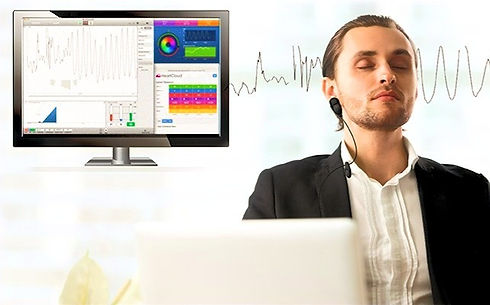
Biofeedback
Effective treatment for:
-
Anxiety and Stress
-
PTSD
-
ADHD
-
Chronic pain
-
Sleep disorders
-
Fibromyalgia
-
Headaches
-
High blood pressure
-
Improve Mood
-
Focus and attention
What is Biofeedback?
You control these actions when you raise your hand to wave hello to a friend or lift your knee to take another step on your morning walk. Other body functions like heart rate, skin temperature, and blood pressure are controlled involuntarily by your nervous system. You don't think about making your heart beat faster. It responds to your environment, like when you're nervous, excited, or exercising.
Biofeedback is a mind-body technique in which individuals learn how to modify their physiology to improve physical, mental, emotional, and spiritual health. Biofeedback is a technique you can use to learn to control your body's functions and help prevent or treat conditions including anxiety, stress, PTSD, attention deficit hyperactivity disorder (ADHD), depression, chronic pain, fibromyalgia, migraine headaches, chronic pain, high blood pressure, and other conditions.
What does Biofeedback do, and how does it work?
With biofeedback, you're connected to electrical sensors that help you receive information (feedback) about your body (bio). This feedback helps you focus on making subtle changes in your body, such as relaxing certain muscles, to achieve results such as reducing anxiety, stress, blood pressure or pain. Biofeedback gives you the power to train your brain to control your body, often to improve a health condition or physical performance.
Biolife Health Center uses several different biofeedback methods. Determining the right method for you depends on your health problems and goals. Biofeedback methods include:
-
Brainwave - This method uses scalp sensors to monitor your brainwaves with an electroencephalograph (EEG).
-
Breathing - During respiratory biofeedback, bands are placed around your abdomen and chest to monitor your breathing patterns and respiration rate.
-
Heart rate—This type of biofeedback uses finger or earlobe sensors with a device called a photoplethysmograph, or sensors placed on your chest, lower torso, or wrists with an electrocardiograph (ECG), to measure your heart rate and heart rate variability.
-
Muscle - This method of biofeedback involves placing sensors over your skeletal muscles with electromyography (EMG) to monitor the electrical activity that causes muscle contractions.
-
Sweat glands - Sensors attached around your fingers or on your palm or wrist with an electrodermograph (EDG) measure the activity of your sweat glands and the amount of perspiration on your skin, alerting you to anxiety.
-
Temperature - Sensors attached to your fingers or feet measure your blood flow to your skin. Because your temperature often drops under stress, a low reading can prompt you to begin relaxation techniques.
What does Biofeedback treat?
Biofeedback, sometimes called biofeedback training, is used to help manage many physical and mental health issues, including:
-
Anxiety
-
Stress
-
PTSD
-
Attention deficit hyperactivity disorder (ADHD)
-
Depression
-
Chronic pain
-
Sleep disorders
-
Fibromyalgia
-
Headache
-
High blood pressure
-
Raynaud's disease
-
Stroke
Biofeedback appeals to people for a variety of reasons: it's noninvasive, It might reduce or eliminate the need for medications, a treatment alternative for those who can't tolerate medications, an option when medications haven't worked well, an alternative to medications for some conditions during pregnancy. and it helps people take charge of their health.
Scientific Evidence for Biofeedback
Clinical biofeedback training is steadily gaining acceptance with the American public. The last decade has demonstrated a significant increase in the prevalence of complementary medicine. A recent in‐person survey of health‐and illness‐related experiences showed that in the USA alone, approximately 38% of adults and 12% of children are using some form of complementary medicine for general healthcare and wellness or to treat a range of symptoms and diseases.
As more and more Americans seek out such complementary therapies for their healthcare and as research continues to reveal the efficacy of biofeedback for more and more medical disorders, it has become an accepted therapy for more disease conditions. Continued research by the Cleveland Clinic, with funding from the Bakken Heart-Brain Institute, seeks to investigate the efficacy of biofeedback in treating three populations of patients – those with coronary artery disease, diabetes or multiple sclerosis. Biolife Health Center continues to establish in these and other diseases that biofeedback is successful in improving quality of life and clinical status and possibly reversing biological aspects of each disease.
TESTIMONIALS

“I, my staff, and my family use this device. Many people do not know how to intentionally create the emotional states they want. The software trainer is ideal for easily and effortlessly accomplishing this.”
Jack Canfield, co-creator of Chicken Soup for the Soul, co-author of The Success Principles
“Biofeedback has helped me with relaxation and stress relief without the use of medication. It has been a lifesaver for me in waiting rooms and crowded areas. People think I am just listening and training using my I-Pad or smartphone.”
Carla M.
“I like this, it is great, I do not use it as much as I wished to, but I will use it more because it helps me break the normal habitual breathing pattern. Proper oxygenation of the body through breathing exercises can be insanely powerful, and this tool has the capability to make it done right.”
Julia V.
"The benefits I have received are greater emotional control and resilience to stress and emotional triggers, greater emotional flexibility to get back into coherence when I fall out, a greater level of inner peace and joy throughout my day, deeper sleep than ever before and an overall improvement in my wellness.”
Christian Long
- 01
- 02
- 03
- 04
- 05
- 06
- 07
- 08
- 09
- 10
- 11
- 12